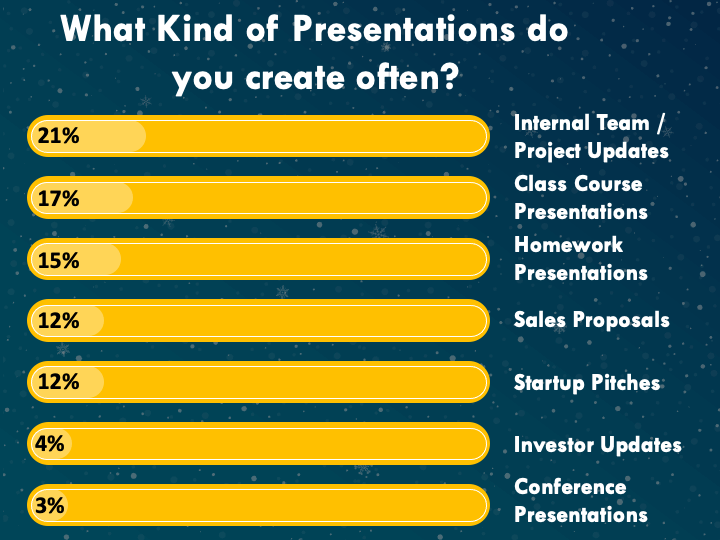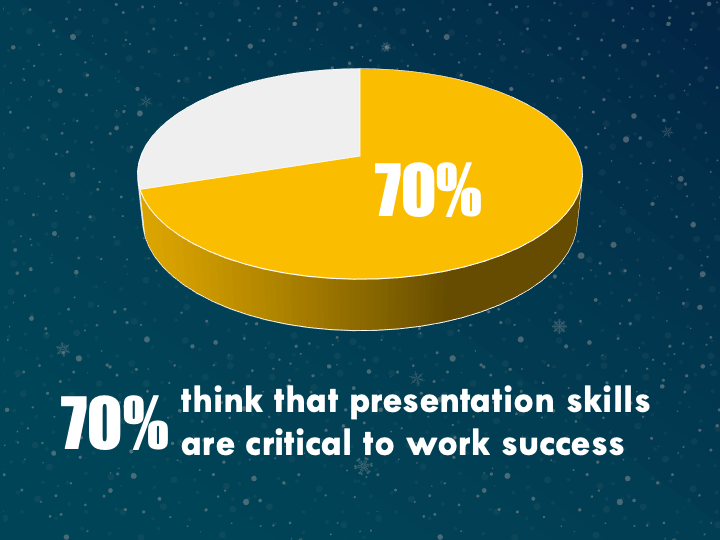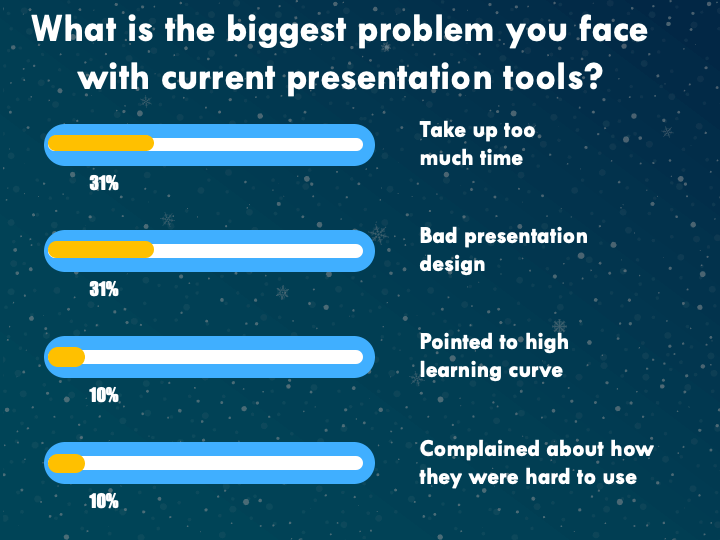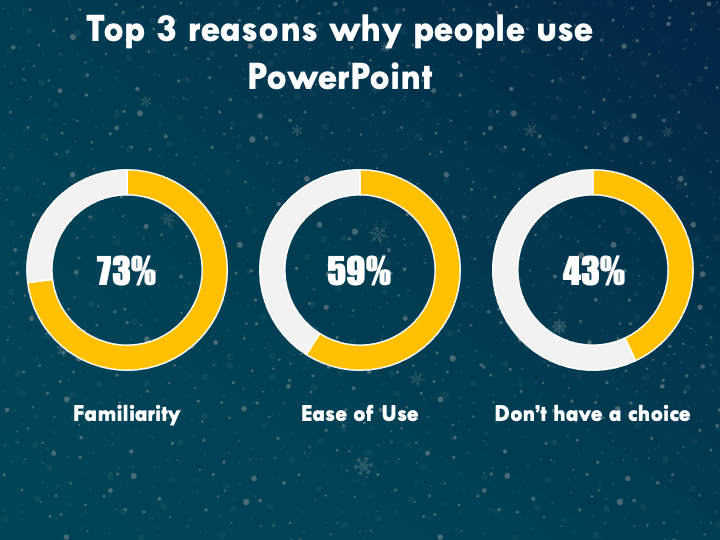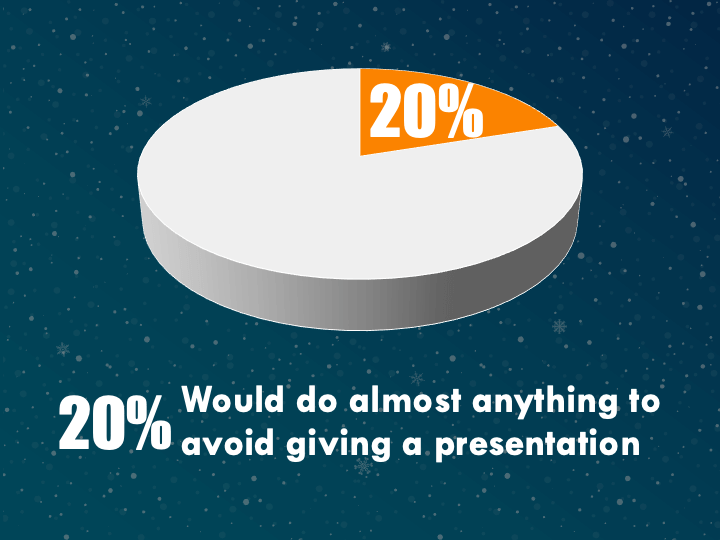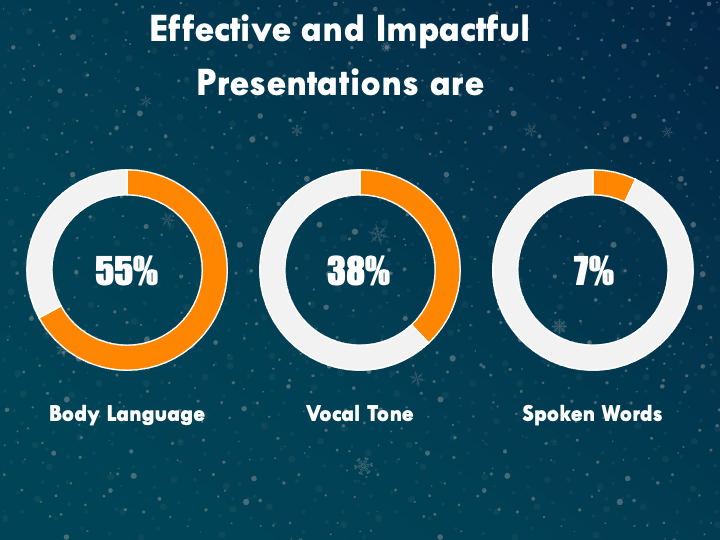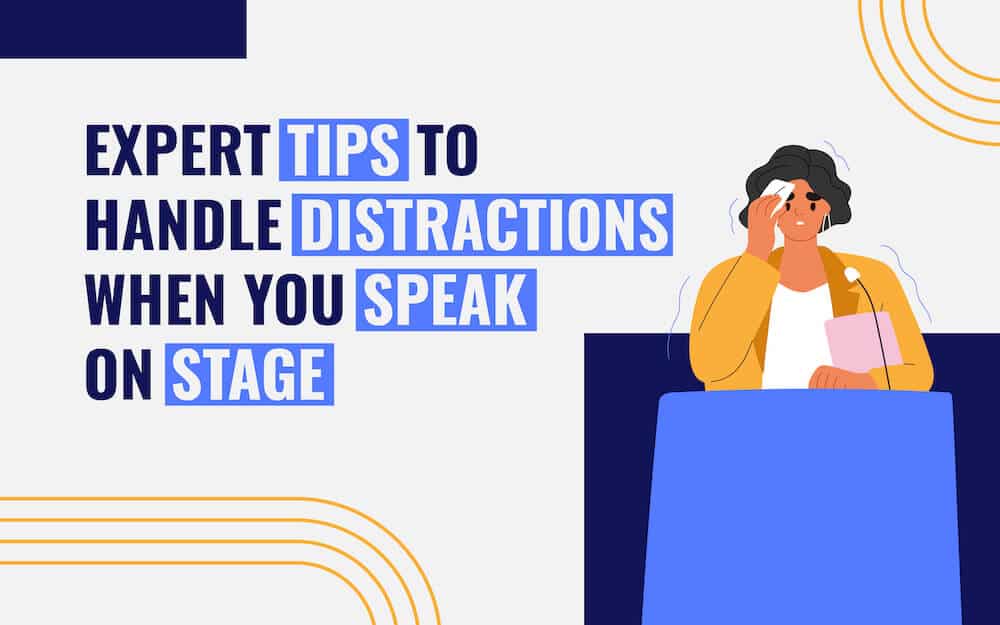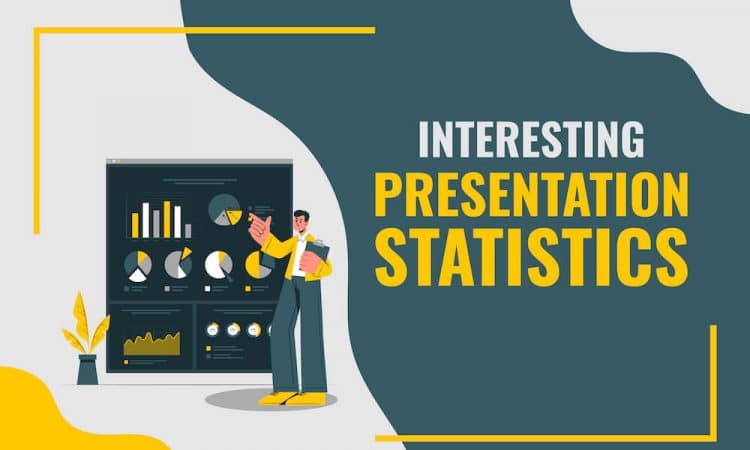
A good presentation helps you win new projects and investments, get management approvals, influence decision-makers and stakeholders, establish yourself as a thought leader in the industry, and more. By leveraging the power of presentations, you can boost your brand image, increase sales, and open doors to new opportunities for your business.
You will be surprised to know that in a survey, approximately 10% of respondents said they created presentations on a daily basis, while 30% of them created presentations 1-3 times per month.
In this article, we have included many such shocking statistics that will help you understand various aspects of presentations. Let’s take a look!
1. Presentations are Created to Accomplish Various Goals
What Statistics Say:
In a survey, 47% of speakers stated that they designed presentations with the objective of summarizing complex information to make it easier for their audience to understand the content.
According to a source, 24.5% created slide decks to entertain and inspire their audiences. 16.7% created presentations to share a case study of personal experiences or tell a story to their audiences.
2% of speakers paid attention to sharing specific facts and statistics, while 9.8% of speakers focused on breaking down complex topics into smaller inputs to enable the audience to understand the key takeaways. (source)
According to a survey, 32% of participants create presentations for course assignments or homework. 21% of people create presentations for project updates and internal teams. The rest 12% create startup pitches while the other 12% create sales proposals. 4% create presentations for investor updates. In a nutshell, approximately ⅔rds of presentations were meant for business needs.
Expert Tips:
Each presentation is delivered to accomplish a specific goal – it could be to educate, inform, persuade, activate, inspire, or entertain. A good presentation combines all these goals; however, one goal should be the backbone. So, to ensure your presentation’s success, invest some time figuring out what you want to achieve.
For setting presentation goals, you first need to research your audience to understand their needs and wants. Then write your goals. After that, find the overlap between your and your audience’s goals and align your presentation’s objectives with them.
2. Re-engaging the Inactive Audience is Crucial
What Statistics Say:
According to a source, the average attention span of the audience is only 8 to 10 minutes. The participation levels of the audience begin to drop off after 30 minutes (source).
In a survey, almost 50% of the respondents admitted to engaging in something other than listening during a co-worker’s presentation – 28% were busy sending a text message, 27% checking email, and 17% fell asleep.
So, it’s important to re-engage the audience from time to time to make them understand and retain your message. An engaged audience connects with your content emotionally and logically and actively participates in your presentation.
Expert Tips:
Presenters have only 3 seconds to hook the audience (source). You can use the following tips to make the most of those few moments and grab the audience’s attention-
- Begin your presentation impressively. You can include a thought-provoking question, anecdote, quote, fact, statistic, or eye-pleasing visual for a memorable start.
- Focus on data visualization to make complex information and concepts comprehensible.
- Back your presentations with facts and figures to increase audience retention by 30%.
- Incorporate live polls, videos, and icebreaker questions to turn the disengaged audience into active ones.
- Invite a few members to the stage and ask them to share their ideas, opinions, and feedback on the topic.
3. Presentation Skills are a Must for Career Growth
What Statistics Say:
In a survey (conducted by Prezi and published by Forbes), about 70% of the people who present regularly accepted that presentations are critical to their work success.
According to a survey, executives with excellent presentation skills are 50% more likely to get promotions than those who don’t have these skills. (citation source)
In a study, it was found that professionals who leverage presentation opportunities to put across and strengthen their brand message get a 33% higher recognition rate in their industry. (citation source)
In a survey conducted among Fortune 500 companies, executives agreed that 40% of progress in their careers is due to their ability to present ideas effectively. (citation source)
Startup founders with excellent presentation skills have 50% more chances to secure investment in comparison to those who don’t have these skills. (citation source)
According to a report, job candidates who demonstrated strong presentation skills and abilities during interviews had 30% more chances to receive job offers. (citation source)
Expert Tips:
The importance of presentation skills in the career growth and workplace can’t be overlooked. Presentations are delivered not just to get approval from management or pitch a client but also to share project updates with the team, provide insights into the company’s financial status to stakeholders, etc.
Effective presentation skills help reduce stress levels, improve other crucial career skills, boost leadership qualities, and acquire and retain clients. So, master these skills and open doors to various opportunities!
4. Visuals Make Your Presentations More Convincing
What Statistics Say:
According to surveys, 84.3% of presenters prefer designing visually focused presentations. (citation source)
According to studies, 41% of presenters face challenges finding and using visuals in their presentations.
34.3% of presenters mostly use stock photos and photographs in their presentations. 18.6% use original charts and graphics. 7% use icons and illustrations. 6.9% use GIFs and memes. 5% use screenshots. (source)
Presentations supported with visual aids are 43% more convincing than the same presentations without visuals. (source)
It takes just ¼ of a second to process symbols and pictures by the audience. (source)
Expert Tips:
High-quality visuals, such as charts, images, infographics, etc., add a layer of interest, creativity, insights, emotional impact, and credibility to your textual information and make your presentation more inclusive and memorable.
Follow these tips while choosing visuals:
- Don’t use visuals merely for beautifying your slides; use them with a purpose.
- Choose visuals that best complement and strengthen your core message.
- Opt for high-definition visuals to ensure clarity on all screen sizes.
- Choose the right color for your visuals that reflect your emotions and brand identity.
5. A Concise Presentation Leaves a Lasting Impression
What Statistics Say:
In a survey, 2% of speakers said their presentation lasted between 45 and 60 minutes. Only 6.9% said their presentation concluded in less than 25 minutes. (citation source)
25% of your presentation time should be reserved for a Q&A session. (source)
Expert Tips:
- Follow the 10/20/30 PowerPoint rule to make your presentations concise.
- Include only relevant content in your slides.
- Instead of text, use data visualization to showcase complex numbers and statistics.
- Learn the skills to master long presentations.
6. Design Can Make or Break Your Presentation
What Statistics Say:
47% of presenters who created a deck on their own said it took them over 8 hours to create it. (source)
According to research, 45% of presenters encounter difficulty in designing creative layouts for their presentations.
7% of presenters face problems in finding eye-pleasing fonts for their presentations. (source)
According to a study, 65.7% of presenters don’t seek professional help for designing presentations; they prefer to do it on their own. Only 4.9% prefer to hire or seek help from designers.
29.4% of speakers agreed that they designed some parts of their presentations themselves and also sought assistance from a designer. (source)
60% of presenters said despite using a template the last time while working on PowerPoint or Google Slides, they were not confident in their work. (source)
According to 42% of people, presentation tools should focus on offering design-related aids. (source)
Expert Tips:
Presentations speak volumes about your brand and business. Cluttered, disorganized, and unprofessional-looking slides overwhelm your audience and deviate them from the core message. So, instead of settling down for a boring and dull presentation, learn PowerPoint design principles and the latest trends to design your slides outstandingly. And if design is not your forte, you can hire or seek help from design specialists.
7. Pre-Designed Presentation Templates are a Great Savior
What Statistics Say:
In a survey, 31% respondents admitted that they invest too much time in creating a presentation with the help of a tool. 31% said the design of presentations created using tools are not impressive.
Approximately 50% of presenters started creating their presentation from scratch; however, they found it difficult to complete. 21% said they searched for templates, 15% agreed that they worked on an existing template, and 8% preferred recycling a used presentation. (source)
In a survey, 75% of participants stated that they had reused the same slide deck at least once to this day. Approximately 30% of them have reused the same deck over five times.
In a survey, 8.9% of presenters stated that they faced difficulty in finding a clutter-free template or design.
Expert Tips:
Designing slides from scratch is tedious and time-consuming, especially if you are running short of time or you don’t possess design skills. In such a case, pre-designed templates come to your rescue, which lets you customize the design elements effortlessly.
While choosing the PowerPoint templates, consider the following points:
- The topic of your presentation.
- Your audience – whether they are corporate executives, medical professionals, students, etc.
- If the template is 100% editable and offers customer support services.
- Does the template have visuals relevant to your content?
- Is the template multipurpose and reusable?
8. Audience Prefers Story in Presentations
What Statistics Say:
Researchers found that out of 500 TED Talks, 65% that went viral included personal stories. (source)
According to 90% of people, a strong narrative in a presentation is important for engaging the audience. (source)
Researchers at Ohio State demonstrated that people can get so engrossed in a story that they hardly notice the world around them. (source)
46% of presenters believe that crafting an engaging story is the hardest part of presentation creation.
55% of people agreed that content with a great story engages them. (source)
Audiences are 22 times more likely to recollect a fact if it is woven into a story. (source)
Expert Tips:
An overarching story makes your information and data more relatable to the audience, taking them on a journey and eliciting emotional responses. Moreover, stories contextualize your presentations and encourage the audience to take action.
Keep the following points in mind while crafting a story for your presentation:
- Create your story around 3 elements: trust/authenticity, creativity, and relevance.
- The story must relate to the goals and challenges of your target audience.
- The story must tap into the audience’s emotions.
- Use relevant images and visuals to complement and strengthen your story.
9. PowerPoint is Still the #1 Preferred Tool
What Statistics Say:
Despite having dozens of better presentation creation tools at their disposal, 89% of presenters still prefer to use PowerPoint. (source)
73% of presenters use PowerPoint because they are familiar with this tool, 59% of presenters find it easy to use, while 43% have no choice other than to use it. (source)
Approximately 35 million PowerPoint presentations are created every day. (source)
Expert Tips:
PowerPoint has revolutionized the presentation world. With its seamless compatibility with a wide range of operating systems and devices, intuitive design, vast library of pre-designed templates, and other user-friendly features, PowerPoint is the preferred choice of many presenters from different professional spheres.
Whether a beginner or an experienced presenter, you can make the most of PowerPoint like a pro by learning useful tips and tricks.
10. Color Psychology Can Boost Your Presentation Design
What Statistics Say:
35.3% of presenters prefer using vibrant and bright color palettes over brand colors. Only 16.7% of presenters use corporate, cool, and blue colors. (citation source)
According to a statistical report, 11.8% of presenters prefer darker and bolder color patterns, 9.8% like natural and earthy tones, and 7.8% prefer red and fiery color schemes. Only 3.9% like subtle and pastel colors.
Expert Tips:
Colors have the power to influence the perceptions, behavior, and emotions of the audience. By picking the right colors for your presentations, you can reinforce brand identity, enhance understanding and memory retention, and evoke a distinct mood.
Consider the following points while selecting color for your presentation:
- Use colors sparingly for titles, icons, text, backgrounds, calls to action, and other important elements.
- Use a maximum of 3 or 4 colors per slide to create visual hierarchies.
- The chosen colors should have enough brightness and contrast to be visible clearly on different screen sizes and lighting conditions.
- Don’t be afraid to experiment with different colors to identify the right color scheme that best complements your content.
- Use primary, secondary, and tertiary colors sparingly to create harmony, contrast, and balance.
11. Constant Practice Considerably Reduces Presentation Anxiety
What Statistics Say:
In a survey (published by Forbes), 20% of respondents said they would do almost anything to avoid presenting.
90% of the anxiety we feel before making a presentation comes from a lack of preparation. (source)
A study states that professionals who regularly involve themselves in presentation skill development activities report a 40% increase in message retention by their audiences and a 60% improvement in audience engagement. (citation source)
A 75% decrease in presentation anxiety was reported by individuals who regularly engaged in public speaking practice sessions. (citation source)
Expert Tips:
Fear and anxiety while delivering presentations are inevitable, no matter whether you are presenting for the first time or the 50th time. However, these feelings can be substantially controlled by practicing regularly.
With constant practice, you:
- learn to handle distractions on the stage.
- get familiarized with your material, which boosts your confidence.
- identify speaking flaws and work on them to deliver an outstanding presentation on the stage.
- learn better time management that enables you to deliver your presentation on time without missing any information.
- learn to use different elements of body language to create maximum impact.
12. Presentation Delivery Affects Audience Engagement
What Statistics Say:
In a survey, 4 out of 5 professionals stated that they lost their focus due to the poor delivery skills of the presenter.
91% of presenters feel more confident delivering presentations with a well-designed slide deck. (source)
In a survey, 46% of respondents admit that they get distracted during a co-worker’s presentation for many reasons: irrelevant content, monotonous presentation style, technology glitches, etc.
According to studies, effective and impactful presentations are 38% your voice, 55% non-verbal communication, and only 7% your content.
75% of presenters would like to improve their presentation skills. (source)
Non-verbal expression is 65% to 93% more influential than text. (source)
Expert Tips:
Usually, audiences forget what you said; however, they remember how you make them feel. Even if the structure, design, and content of your presentation are appealing, the poor delivery can ruin the impact. So, you must pay attention to your presentation delivery as well.
Here are a few tips to improve your delivery:
- Instead of choosing the presentation tool that you are most familiar with, select the one that best fits your delivery. For example, you need different tools for one-on-one presentations and presenting to a boardroom full of CEOs and senior executives. Similarly, webinars and conferences need different tools than an in-person team meeting in a room.
- Don’t use unclear accents, words, or terms. If you use a specific term or word, explain its context.
- When delivering presentations, pay heed to the vocal expression (volume, tone, and pitch of your voice).
13. Content-Focused Design: A Seamless Integration of Text and Visuals
What Statistics Say:
40% of presenters prioritize content and text while preparing slides. 15% focus on quotes, 25% on images, and 10% on video. (source)
In a survey, 33.3% of respondents said they started creating their presentations with an outline or content instead of thinking about design. 4.9% thought about the presentation design or theme, giving the content a last thought. 32.4% of presenters considered the content and design simultaneously.
Expert Tips:
Both content and design matter in a presentation. Remember, good content alone can’t compensate for poor or below-par design and vice versa.
A content-focused design approach is recommended to deliver a valuable experience to the audience. Outline your content first and then decide the visuals and design to fit the content. This approach helps you structure your slides well, resonating with the presentation’s theme and the audience’s expectations.
14. Virtual Presentations are Here to Stay
What Statistics Say:
Harvard Business Review authors say 80% of corporate presentations nowadays are delivered remotely.
In a survey, a quarter of respondents said they prefer presenting remotely, while 33% found it difficult to deliver remote presentations.
Expert Tips:
Virtual presentations are the new normal now. They offer several benefits, such as a wider reach regardless of time zone and location, cost-effectiveness, convenience and flexibility for attendees, etc. One thing to remember is that in-person and virtual presentations need different delivery approaches.
Below are a few tips to ace your virtual presentations:
- Be camera-confident.
- Dress appropriately, as it affects your confidence.
- Make your slides interactive to keep the audience engaged.
- After the presentation, share the link to the recorded meeting with your audience and schedule a follow-up meeting.
15. Adding Interactivity is a Game-Changer for Presentations
What Statistics Say:
81% of marketers believe in the effectiveness of interactive content for engaging the audience. (source)
Presentations that incorporate two-way interaction are likely to persuade 65% of people more easily. (source)
68% of people believe that presentations with interactive elements are more memorable. (source)
Expert Tips:
- Integrate quizzes, polls, music, narratives, audio, and video clips to add a layer of interactivity to your presentations.
- Encourage your audience to share the stage and ask questions or share their thoughts, feedback, and viewpoints.
- Enrich your presentations with animated stories and data visualizations.
- You can integrate AR and VR technologies into your product demonstration and orientation presentations to take your audience on a virtual journey.
Conclusion
These statistics will help you get valuable insights and aid you in your next presentation creation. If you have more such statistics, do share them in the comments below.
